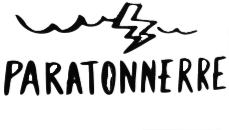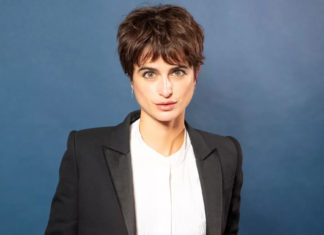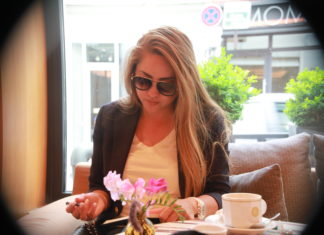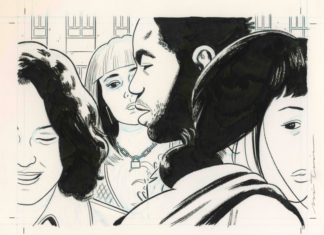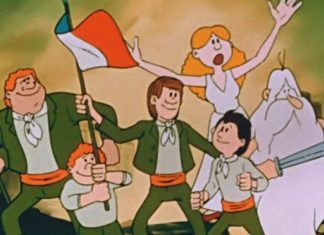Susan Copich est une célèbre artiste-photographe. Mère de deux enfants, elle a crée une série « Domestic Bliss », ensemble de photos la représentant dans des situations d’humour noir et de vie exagérée. Interview avec une incroyable artiste.
– Comment votre carrière d’artiste à débuter et est-ce que cela toujours été dans le domaine de la photographie?
J’ai débuté en tant que danseuse moderne et chorégraphe à New York et à San Francisco au début des années 90. Après une blessure grave au genou, j’ai commence à étudier la  comédie et j’ai fait des castings. J’adore le concept de création de personnages. C’est formidable de développer une histoire antérieure au rôle et l’enrichir avec ses propres pensées et expériences. C’est vraiment complet, inclusif et motivant. Pendant ma carrière d’actrice, j’ai commencé en même temps des cours de photographie à l’International Center of Photography à New York.
comédie et j’ai fait des castings. J’adore le concept de création de personnages. C’est formidable de développer une histoire antérieure au rôle et l’enrichir avec ses propres pensées et expériences. C’est vraiment complet, inclusif et motivant. Pendant ma carrière d’actrice, j’ai commencé en même temps des cours de photographie à l’International Center of Photography à New York.
– La série de photos ‘Domectic bliss’ a une vision sobre et ironique de la famille. Comment l’idée est venue ?
“Domestic Bliss” est né avec une image Split Milk. Alors que je participais à un cours de photos sur le travail de Cindy Sherman, j’ai été très intéressée sur le fait qu’elle était elle-même actrice de son art. J’ai alors commencé à faire des auto-portraits puis mes propres histoires et intrigues.
Me mettre devant l’objectif n’est pas un acte gratuit. C’est le fruit d’années d’expérience : Apprendre et prendre le contrôle de mon corps, imaginer des intrigues afin d’exprimer différentes émotions et de les jouer.
Je suis familière à l’improvisation dans la danse et au théâtre et je continue à utiliser ces principes dans mon travail. Une simple prémisse d’improvisation est une construction délicate et les règles et opportunités sont infinies. Lorsque j’ai réalisé Split Milk, je me suis dit un ordre : Ne pas pleurer pendant le shooting. De là, j’ai crée un personnage comme je faisais lorsque j’étais actrice. J’ai toujours essayé de dire « oui et » (première règle de l’improvisation) puis il y a tout le temps de changer l’aspect plus tard.
Ce n’est qu’avec la seconde photo Old Habits un an plus tard que j’ai fait participé ma famille et commencé une série entière. Tout le processus est long à commencer. Notre famille reçoit un nombre incroyable de cartes de vœux avec le mot « happy ». C’est bien souvent déconcertant et difficile à comprendre que tout le monde soit aussi joyeux. J’ai alors voulu montrer l’intimité de ma famille plutôt que de la cacher. C’est ainsi que Domestic Bliss est né. J’ai commencé à repérer les contradictions dans la vie. J’ai révélé les côtés sombres de la famille, cherchant partout : les journaux, mes croyances, les conversations avec des amis, la vision de ma génération sur l’âge adulte, sur les questions politco-sociales. Bref, la réflexion est sans fin, riche et profonde. Je me suis autorisée à avoir des pensées sombres et ensuite j’ai contré celles-ci avec l’humour. C’est une vraie réflexion.
et commencé une série entière. Tout le processus est long à commencer. Notre famille reçoit un nombre incroyable de cartes de vœux avec le mot « happy ». C’est bien souvent déconcertant et difficile à comprendre que tout le monde soit aussi joyeux. J’ai alors voulu montrer l’intimité de ma famille plutôt que de la cacher. C’est ainsi que Domestic Bliss est né. J’ai commencé à repérer les contradictions dans la vie. J’ai révélé les côtés sombres de la famille, cherchant partout : les journaux, mes croyances, les conversations avec des amis, la vision de ma génération sur l’âge adulte, sur les questions politco-sociales. Bref, la réflexion est sans fin, riche et profonde. Je me suis autorisée à avoir des pensées sombres et ensuite j’ai contré celles-ci avec l’humour. C’est une vraie réflexion.
J’adore travailler avec la contradiction. Cela permet de la vie, de l’énergie et de la tension. Il n’y a pas mieux que d’avoir la pureté des enfants avec l’aspect sombre et tordu du monde adulte dans la même photo. C’est électrique. Un ami m’a envoyé une fois une citation de Gaston Bachelard : « Tout prend vie lorsque les contradictions s’accumulent ». Je ne peux qu’être d’accord.
-La figure de l’homme/père est sans visâge dans votre série. Pensez-vous que le patriarcat est le principal dominant dans nos sociétés ?
Bien sûr. Regardez comment les dernières élections américaines se sont déroulées, comment les gens se réfugient chez eux, regardez la différence entre le nombre d’artistes  hommes et le nombre d’artistes femmes dans les expositions et musées. Les hommes sans tête dans ma série c’est intentionnel et non expliqué.
hommes et le nombre d’artistes femmes dans les expositions et musées. Les hommes sans tête dans ma série c’est intentionnel et non expliqué.
Le personnage féminin est en fait l’héroïne de mes photos. Elle est tout à la fois : la victime, l’agresseur, le martyr, la catin. Elle est faillible, féroce, complexe avec de multiples aspects.
-C’est un vrai plaisir de travailler avec vos filles?

Une vraie joie de travailler avec elles et de créer des histoires. Ce sont de formidables petites actrices. Elles ne participent plus à mes photos et par conséquent la série est suspendue. Elles ont maintenant 14 et 10 ans et veulent être libres de faire ce qu’elles veulent sans l’aide de leur mère. Je suis ravie qu’elles aient pu participer à ce projet et on peut les voir grandir tout au long du processus. C’est incroyable.
– Vous voyez votre personnalité se refléter dans votre travail?
Complètement. Cela transpire dans mon travail. Durant ma toute première interview, c’était avec Slate, j’ai dit :
« Chaque image que je crée est une vraie réflexion de moi-même. Pas seulement dans le contenu mais tout le processus. Je crois que ma plus grande fierté est lorsque le public voit  mon travail, il y a une réaction et un voyage qui se superposent et si vous prenez le temps vous pourrez voir toute l’émotion et le conflit. La première réaction est le rire, le choc ou l’esprit commerçant. C’est tout moi. »
mon travail, il y a une réaction et un voyage qui se superposent et si vous prenez le temps vous pourrez voir toute l’émotion et le conflit. La première réaction est le rire, le choc ou l’esprit commerçant. C’est tout moi. »
Avec tout le processus artistique, j’ai appris que mon psychisme sera toujours présent dans mon travail. Je crois que c’est là où la magie arrive.
-Qui sont vos photographes préférés? Votre travail a également un aspect cinématographique. Des films préférés?
Mes artistes préférés sont Cindy Sherman, Annie Leibowitz, Gregory Crewdso n, Sally Mann, Jackson Pollack, Edward St Aubyn, Sylvia Path, Mike Leigh, David Lynch, Vim Vandekeybus, Pina Bausch et Trisha Brown. Ce sont des peintres, des photographes, des poètes, des écrivains, des chorégraphes et des metteurs en scène. Tous ont révélé une part d’eux-mêmes dans leur travail volontairement ou involontairement.
n, Sally Mann, Jackson Pollack, Edward St Aubyn, Sylvia Path, Mike Leigh, David Lynch, Vim Vandekeybus, Pina Bausch et Trisha Brown. Ce sont des peintres, des photographes, des poètes, des écrivains, des chorégraphes et des metteurs en scène. Tous ont révélé une part d’eux-mêmes dans leur travail volontairement ou involontairement.
Je suis passionnée par le cinéma depuis l’âge de 10 ans. Mes films préférés sont toutes les œuvres de Mike Leigh, la plupart, “Life is Sweet”, “Blue Velvet” de David Lynch; “Kiss of the Spider Woman”, Presque tout de Woody Allen pour différentes raisons, le talent incroyable de Quentin Tarantino, surtout dans “Django” – c’est du pur génie. Je n’en cite que quelques-uns.
Quels défis et opportunités vous avez eu à prendre des photos en Inde et comment avez-vous abordé cette série ?
J’adore prendre des photos en Inde. Les gens sont chaleureux et accueillants,
l’air se mêle à l’énergie. Le mouvement et les contradictions sont partout. La difficulté et le plaisir de prendre des photos dans les rues permettent d’avoir une énergie libérée. Il faut savoir trouver l’image pour rendre sens au chaos tout en étant ouvert à l’inattendu. C’est super d’éveiller ainsi ses sens.
-Comment est la vie dans un pays où Donald Trump est président ?
Eh bien, je ne suis qu’une artiste et non une observatrice politique. Mais ce que je peux dire c’est que je suis ravie de voir la passion que l’on trouve dans l’opposition. Les gens reviennent dans la rue, s’organisent pour se faire entendre. Quel plaisir de voir la voix de l’Amérique se rassembler et de tenter de changer la situation de nos quotidiens. Juste pour rappel Hillary Clinton a gagné par le vote populaire de 3 000 000 de voix. Ce n’est pas rien ! Le collège électoral est un système cassé et nous devrions repenser notre système d’élections. J’en terminerai là avant que je ne puisse plus m’arrêter.

Susan Copich is a well-known fine art photographer. Mother-of-two, she creates the series “Domestic Bliss,” staged photos featuring her in darkly humorous scenes from an exaggerated life. Interview with an outstanding artist.
– How did your art career start, and was it always photography centered?
My art career began as a modern dancer, performer and choreographer in NYC and San Francisco, CA in the early 90s. After a severe knee injury, I began studying acting and
in NYC and San Francisco, CA in the early 90s. After a severe knee injury, I began studying acting and
auditioning for roles. I love the character creation part of acting; it is intriguing to develop a fictional, back story from my own thoughts and experiences – it feels expansive, inclusive and playful. While pursuing acting I simultaneously began photography classes at International Center of Photography in NYC.
– ‘Domectic bliss’ was dark and witty humor photography series about family life. How did the idea come to you?
“Domestic Bliss” started with an image, “Split Milk”. While participating in a photography class we studied Cindy Sherman’s work, I was drawn to her art being a performer myself. I took her initial idea of the self portrait, then added my own twist of drama and story.
Placing myself in front of the camera is not gratuitous, it is intentional and bursting with years of experience: learning about and taking control of my body; creating anecdotes I can relate to in order to access different emotions, performing since childhood.
I am trained in contact improvisation (dance), as well as, theatre improv and use these principles in my process. A basic premise behind improvisation is a tight construct (an idea), but within these narrow rules of engagement, opportunities are endless. When I first sat for “Split Milk” I gave myself an idiom, don’t cry over spilled milk, from there I started to create a character – as if I were creating for an acting gig. I always try to initially say ‘yes and’ (first rule of improv), there is plenty of time to edit later.
It is not until my second image, “Old Habits” a year later, that I involve my family and begin to envision an entire series. It is quite organic and slow at the start. Our family receives an  extraordinary amount of holiday cards and the sheer amount of “happy” is often disconcerting – It is difficult to fathom everyone is this cheerful and my reaction is to create a card that reveals a bit too much of a family rather than mask it. This is the moment “Domestic Bliss” is born. I begin looking for contradictions in life. I let the flood gates open to the shadow-side of family, sourcing from everywhere: newspapers, my thoughts/life, friends’ conversations, my generations’ take on adulthood, social/political issues – the material is endless, rich and deep. I give myself permission to think as darkly as I wish, then counter it with humor. It is a meditation on allowance.
extraordinary amount of holiday cards and the sheer amount of “happy” is often disconcerting – It is difficult to fathom everyone is this cheerful and my reaction is to create a card that reveals a bit too much of a family rather than mask it. This is the moment “Domestic Bliss” is born. I begin looking for contradictions in life. I let the flood gates open to the shadow-side of family, sourcing from everywhere: newspapers, my thoughts/life, friends’ conversations, my generations’ take on adulthood, social/political issues – the material is endless, rich and deep. I give myself permission to think as darkly as I wish, then counter it with humor. It is a meditation on allowance.
I love to work with contradiction, it adds life, energy, tension – what better than bringing together the purity of children with dark, twisted, adult emotion in the same frame. It’s electric. A friend just sent me a quote by Gaston Bachelard after discussing my work, “Everything comes alive when contradictions accumulate.” I couldn’t agree more.
– The father/male is a faceless figure in those series. Do you think patriarchy is still the main ruler in our societies?
Of course patriarchy is the main ruler in our society, just look at how Americas’ election played out this year, also closer to home, take note of the ratio of men to women represented in galleries and museums. The headless men in my series is calculated and I  think the point is made without explanation.
think the point is made without explanation.
My female character is portrayed as the ultimate archetype/hero. She gets to be everything from the victim to the aggressor, the martyr to the whore, playful to subversive. She is fallible, fierce, complex and multi-dimensional.
– Is it a real pleasure to work with your daughters?

It is a joy working with my daughters’ on set and creating with them. They are great little actors and take direction well. I no longer have their interest/cooperation, so the series is suspended. Presently, they are 14 and 10 years old and just want to do what theydo, sans their mother’s vision. I am grateful they participated as long as they did and I have a slice of them growing up in front of the camera in these complex images, it’s priceless.
– Do you see your personality reflected in your work?
I absolutely see my personality in my work, it is sweating with it. My first ever interview, with Slate magazine, I said,
“Each image I create is a true reflection of me—not necessarily the content, but the actual slow burn experience. I think this is what I am most proud of, when people experience my work there is a layered reaction and journey and if you give it time all these layers of emotion and character and conflict are revealed and not just the rich underbelly stuff, but the initial reaction of laughter, shock and commercialism that first appear—it is all me.”
work there is a layered reaction and journey and if you give it time all these layers of emotion and character and conflict are revealed and not just the rich underbelly stuff, but the initial reaction of laughter, shock and commercialism that first appear—it is all me.”
I have learned through my process, as an artist, that my psyche will always be present in my work, I believe this is where magic happens.
– Who are some of you favorite photographers past or present? Your work has also a real cinematic style. Any favorite movies?
My favorite artists are, Cindy Sherman, Annie Leibowitz, Gregory Crewdson, Sall y Mann, Jackson Pollack, Edward St Aubyn, Sylvia Path, Mike Leigh, David Lynch, Vim Vandekeybus, Pina Bausch and Trisha Brown to name a few. They are painters, photographers, poets, writers, choreographers and directors. All of them reveal a piece of their selves in their work
y Mann, Jackson Pollack, Edward St Aubyn, Sylvia Path, Mike Leigh, David Lynch, Vim Vandekeybus, Pina Bausch and Trisha Brown to name a few. They are painters, photographers, poets, writers, choreographers and directors. All of them reveal a piece of their selves in their work
if they intent to or not.
Favorite movies – a passion of mine since I was 10 years old – Anything Mike Leigh, most notably, “Life is Sweet”, David Lynch’s “Blue Velvet”; “Kiss of the Spider Woman”, almost anything Woody Allen for many different reasons, the palpable brilliance of Quentin Tarantino, specifically, but not limited to, “Django” – this is sheer genius – to name a few.
– What challenges and opportunities lay in shooting the streets of India and how do you tackle them best?
I love shooting in India, the  people are warm and welcoming, the air is crackling with energy and motion and contradictions abound. The difficulty and pleasure in shooting in the streets of India lay in this unharnessed energy – finding the focus in order to make sense of the chaos, but staying open enough to see the unfolding; it’s a lovely balancing act that requires the senses to be awake.
people are warm and welcoming, the air is crackling with energy and motion and contradictions abound. The difficulty and pleasure in shooting in the streets of India lay in this unharnessed energy – finding the focus in order to make sense of the chaos, but staying open enough to see the unfolding; it’s a lovely balancing act that requires the senses to be awake.
– How’s life in a country where Donald Trump is president?
Well, seeing that I’m an artist and not a political commentator, what I can safely say is that I’m excited by the passion of the opposition and that people are taking to the streets to be heard in organized and thoughtful ways. I am heartened to see the voice of America rising in communal strength and attempting to balance the off-kilter situation we find ourselves waking to every morning. Just remember Hillary Clinton won the popular vote by 3,000,000 – this is NOT insignificant – the electoral college is a broken system and should be strongly reconsidered by next election. I’ll end there before I can’t stop myself.

